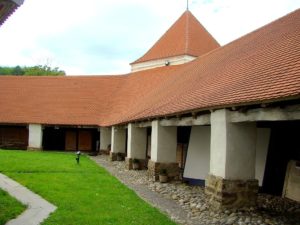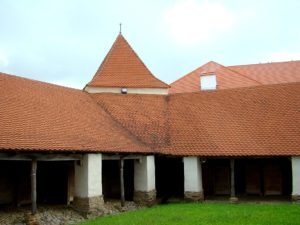Székelyderzs

Székelyderzs is in Székelyföld (Székely Land), on the land of the Hungarian Székely people. It is in Transylvania, Romania, and is called “Darjiu” by the Romanians. Székelyderzs is famous for its Unitarian fortified church and the murals dated in 1419. The fortified church of the village is one of the oldest and most significant historical monuments of the Székelys. The Hungarian runic writing discovered in it is also remarkable. In 2006, this Gothic church was the only Hungarian historical monument that was on the UNESCO list. Here is an aerial video of Székelyderzs:
https://www.youtube.com/watch?v=OUMyx5YrK6M

Gossip says that the church was built by the Saxons. The main buildings are the church, the tower, and the wall around them. All we know is, that the church itself was built at the end of the 13th century and later it was fortified. However, the early-Gothic church was rebuilt in the 15th century and finally, it was completed in the late-Gothic style at the end of the 15th century. The settlement was first mentioned in 1334 as ” Thomas sacerdos de Ers solvit II. banales antiquos”. The stone walls and the bastions were added in the 16th century.

The tower today is 38 meters tall because 10 meters were added in 1866. It is supposed that there used to be a curved stone wall around it. Covered ramparts used to be running around the walls which were detached in 1788 when the church lost its military function. Storage places were built along the inner part of the walls where the peasants could keep their valuables and tools. There were granaries built for this reason while the inhabitants could store their bacon and smoked meat supplies inside the bastions.

According to the findings of dendrochronological research, the timbers used in the sanctuary were cut off in the winter of 1495 while the wood used for the nave’s roof can be dated to the winter of 1499-1500. Comparing the structure to the Saxon fortified churches, Székelyderzs can be considered as quite early construction. The church was repaired in 1606, 1622, 1781, 1788, and in 1834. You can find a similar Székely fortified church in Gelence where we can find another famous mural depicting the deeds of Saint King László, here you can read more about it:
https://www.hungarianottomanwars.com/transylvania/gelence/
Similar to other fortified churches of Transylvania, the peasants stored their food in the church all the time – so in case of danger, they just had to run into the fortress without a fuss. This tradition is still alive among the 99% of Székely inhabitants of the village. Each family had (and still has) its designated storage place. There were strict rules, the storage of the church was locked even in times of peace and the peasants were allowed to get their bacon once a week.

There is a well in the southwestern corner of the wall, its water is still clear and drinkable. There is a many-centuries-old religious tradition attached to it: the people were allowed to get baptized only with the water pulled from this well. The church was taken and suffered damages in 1600 by the soldiers of General Basta. The presently visible walls are 5 meters high, they are from the 17th century. These walls were built after the destruction of General Basta in 1605. They built a defensive level with loopholes and tar-pouring holes on the church building after 1605, the work was paid for by Petky János. The village was sacked and burnt in 1661 by the troops of Pasha Ali. The church was very useful in these times.

As the church belongs to the Unitarian Church, we must mention that the first (and only) Unitarian ruler on Earth was King János Zsigmond who introduced the freedom of religion in Transylvania in 1568. Unitarianism was an official religion in Transylvania since the Diet of Medgyes in 1583. The first bishop was Dávid Ferenc (Franz David Hertel, 1520-1579), a local Hungarian-speaking Saxon.

The benches that now you can see were placed in the church in 1790. The families had their assigned places where they were seated. Until 1871, the bells of the church were tolled at noon only from the Day of Saint George until Saint Michael’s Day. After 1871, the bells were tolled three times a day. the large bell in the tower was cast in Derzs, in 1607, from the money of Petky János. They had a smaller bell cast in 1674 but it was confiscated from the church during WWI for military purposes. A new small bell was made in 1923, from the funds of the villagers.

When the church was renovated in 1929, they were opening up a walled-in window, discovering a brick with Hungarian Székely runic writing on it. The brick is thought to have been made between 1274 and 1431. Historians are divided about the meaning of the text on it, perhaps the text stands for this “Miklós Derzsi apa-pap” (meaning: Miklós Derzsi father-priest).

The organ gallery was built in 1800 but the first organ was replaced in 1837 with the one that can be seen today. Sadly, the metal parts were removed from it during WWI for military reasons and it was repaired only in 1946. You can see nice carved stones on the ceiling of the sacristy. There are two pillar heads above the preaching seat, two human heads which are scorning down on us by making faces. On other pillar-stones next to them, you can see the coat of arms of the Székely people, and there is the coat of arms of the Petky family, a plow.

There are three murals on the southern section of the inner wall. At the entrance, we can see Apostle Paul on the Road to Damascus. It is assumed, that Paul’s face was painted after the mural’s painter. A soldier is holding a flag next to St.Paul, reading its Latin text, experts think that the mural was made in 1419.

We can see Saint Michael the Arch-Angel in the second picture: he is holding a scale where we can see devils and a praying woman.

The third painting is just a fragment, we can see three figures with bishop hats on them. They can either be bishop-saints or the three kings who were visiting Jesus in Bethlehem.

There are three murals on the northern section of the wall, too. When they rebuilt the gallery in 1720, they found fragments of murals depicting the martyr legend of a woman-saint. However, the entire northern wall is dominated by the legend of Saint King László. The murals of the Unitarian church show the legend of the famous knight-king, King László (Ladislaus) I of Hungary. When the nomad Cumans broke into the Kingdom of Hungary, László, still a Duke, along with his cousin (King Salamon I) rode against them and freed a girl from a Cuman warrior.

There was a renovation in 2008 that revealed even the first part of it, the scene when the warrior-saint set out against the intruding nomads. We can see that the bishop of Nagyvárad is giving his blessing from Várad Castle to the king and his army.

Then, we can see the scenes of the “Battle”, the “Chasing of the Cuman warrior”, the “Wrestling”, the “Beheading”, and finally, the “Resting” scenes. The Illuminated Chronicle (Chronicon Pictum, about 1360) tells us this story as follows:
[The] most blessed Duke Ladislaus saw one of the pagans who was carrying off on his horse a beautiful Hungarian girl. The saintly Duke Ladislaus thought that it was the daughter of the Bishop of Warad (*my remark: Várad aka Nagyvárad, Oradea), and although he was seriously wounded, he swiftly pursued him on his horse, which he called by the name of Zug. When he caught up with him and wished to spear him, he could not do so, for neither could his own horse go any faster nor did the other’s horse yield any ground, but there remained the distance of a man’s arm between his spear and the Coman’s back. So the saintly Duke Ladislaus shouted to the girl and said: “Fair sister, take hold of the Coman by his belt and throw yourself to the ground.” Which she did; and the saintly Duke Ladislaus was about to spear him as he lay upon the ground, for he wished to kill him. But the girl strongly pleaded with him not to kill him, but to let him go. Whence it is to be seen that there is no faith in women; for it was probably because of strong carnal love that she wished him to go free. But after having fought for a long time with him and unmanned him, the saintly Duke killed him. But the girl was not the bishop’s daughter.

There is another mural in the northern part of the church, it depicts a priest in a grey robe. He is Saint Antal, the Hermit, accompanied by two women dressed in red, with glory around their heads. Note, that there is a similar picture of Saint Antal in the church of Sepesszombat, dated 1503. As for Saint László, he was venerated among the Hungarian Székelys very much. Here is more about the Székely people:
https://www.hungarianottomanwars.com/essays/who-were-the-szekelys/
Enjoy the reconstruction drawing of Fodor Zsolt:
https://www.youtube.com/watch?v=7TjUhutNSos
Source: partly from http://szekelyderzs.com/templom.html

Dear Readers, I can only make this content available through small donations or by selling my books or T-shirts:
Please, support me with a coffee here:
You can check out my books on Amazon or Draft2Digital, they are available in hardcover, paperback, or ebook:
https://www.amazon.com/dp/198020490X or at https://books2read.com/b/boYd81

My work can also be followed and supported on Patreon: Become a Patron!http://Become a Patron!

https://hungarianottomanwars.myspreadshop.com/all
















































































